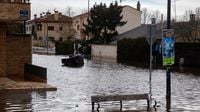As torrential rains continue to batter Spain and Portugal, the escalating conditions have prompted severe flooding and significant disruptions across various regions. The low-pressure system, aptly named "Martinho," has pushed many rivers to the brink of overflowing, particularly threatening the capital city of Madrid.
On March 22, 2025, the Manzanares River, which typically runs low, was observed nearing its limits, raising alarm among residents. Footage broadcast by RTVE showcased the precarious state of the river, which had the potential to breach its banks at any moment.
Further north in Ávila, about 100 kilometers from Madrid, the bullring and several neighborhoods faced inundation, drawing immediate attention from emergency services. Reports indicated that local rivers had overflowed, submerging parts of the city. The situation remained critical as the meteorological service forecasted that the current weather system, "Martinho," would continue to bring rain, significantly cooler temperatures, and even snow in higher elevations lasting until March 25, 2025.
This new weather system replaced "Laurence," which had wreaked havoc earlier in the week, particularly in the southern regions of Andalusia and Murcia, leading to at least two fatalities. As authorities scrambled to assess damages and safety measures, it became painfully clear that Spain’s struggle with persistent rainfall was far from over.
Emergency responders in Toledo, located south of Madrid, were proactive, constructing a dike around a hospital for paraplegic patients situated dangerously close to the Tajo River, in anticipation of potential flooding. Access to numerous roads was restricted, and educational institutions, including universities in the capital, closed their doors in response to the adverse conditions.
In Portugal, strong winds associated with "Martinho" caused considerable disruptions, uprooting trees and resulting in several injuries. The National Maritime Authority (AMN) and the Navy even issued warnings about hazardous conditions at sea from March 21 to March 22, as predictions of severe weather came to fruition.
This relentless assault of torrential rains has not been restricted to isolated areas. Reports indicated that large swaths of Spain experienced continual rainfall for days, prompting authorities to open dam gates to relieve pressure from swelling rivers. Residents have been faced with the distressing necessity of evacuating their homes, especially in areas that had previously witnessed severe droughts.
As of now, several regions such as Extremadura, Madrid, Castilla-La Mancha, and Murcia have become heavily affected by flooding, with emergency services mobilizing to assist those in need. Sadly, the grim toll of the flooding extends beyond property damage; reports confirm that multiple fatalities have occurred in the south of Spain, underscoring the severity of the situation.
In Málaga province, emergency measures included the evacuation of around 400 families due to the risk of flash floods as river levels reached alarming heights. Here, the dual worry looms that the overfull Casasola reservoir is releasing vast amounts of water into the already swollen Campanillas River, further exacerbating the risk to local communities.
The situation reflects a broader context; since the beginning of March 2025, Spain has seen a sequence of four consecutive low-pressure systems attributed to a persistent anticyclone blockage in the North Atlantic. This prolonged series of storms has transformed what was once merely a seasonal weather pattern into a crisis for many residents.
In historic Escalona, the local government issued a warning as the Alberche River overflowed, flooding homes, with some residents compelled to evacuate on March 22, a response that stressed the ongoing need for vigilance. Mayor Álvaro Gutiérrez noted that floodwaters reached heights not seen in forty years.
Local meteorologist Francisco Martín commented, “It’s the wettest March we’ve seen since records began, with rainfall already exceeding what’s expected for the entire spring.” He urged residents to remain cautious, pointing out that not only could upcoming rains further exacerbate flooding, but the potential snowmelt later in the month may present additional challenges.
The aftermath of the previous year’s flooding crises looms large in the minds of residents. Images of tragic losses still vividly recall the destruction witnessed in Valencia, where 230 people lost their lives during a catastrophic flooding event. This time, the authorities are moving swiftly to manage risks, but the threat remains imminent.
The National Weather Service has taken comprehensive measures, informing residents to stay alert and to heed evacuation orders in vulnerable areas. In light of anticipated snow in the mountains and yet more heavy rainfall forecasted, the preparedness efforts reflect the gravity of the unfolding situation on the ground.
As heavy rainfall continues with no immediate relief in sight, the plight of affected residents serves as a stark reminder of the seasonal extremities that Spain faces. While the heavy rains are replenishing reservoirs depleted by years of drought, the immediate danger – flooding and destruction – lingers heavily over many communities.
This situation highlights not only the challenges posed by climate change but also the importance of infrastructure readiness and effective communication in times of disaster. As emergency services continue their diligent work, the hope persists that the worst is yet to pass, and residents can eventually return to their homes and rebuild their lives following the storms.




